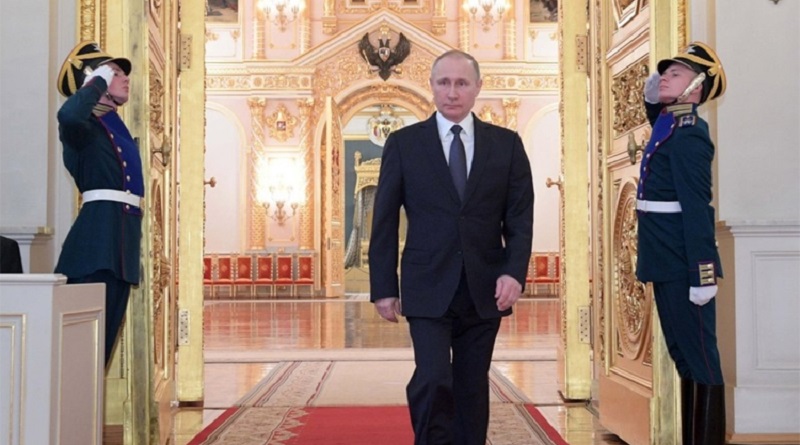Back To the Future: The Kremlin’s Vision of the Russian Information Society
by Ari Axelrod
 For several generations of Soviet citizens this device (see right) would be instantly recognizable. The early pre-WWII models came only in black and were of round shape, colloquially called “tarelka” (dinner plate). Later models introduced in the ’60’s and ’70’s looked more like a wooden box, perhaps 12″x6″x4″ in size, and came mostly in brown and white. Most of them had one control button, but top-of-the line models – many families would be proud to own one – had two. To a foreign visitor, these boxes looked like portable radio sets. But they were not wireless radios. They were “reproductors,” loudspeakers fed by a wire and capable of playing only one channel, so called Program One, a carefully curated stream of government-approved news, propaganda, soccer commentary, and classical music. Once a week – on Sundays – it would feature a humor talk show, lampooning thoroughly noncontroversial subjects such as alcoholic husbands, petty marketplace thieves, and – of course – Western Imperialists.
For several generations of Soviet citizens this device (see right) would be instantly recognizable. The early pre-WWII models came only in black and were of round shape, colloquially called “tarelka” (dinner plate). Later models introduced in the ’60’s and ’70’s looked more like a wooden box, perhaps 12″x6″x4″ in size, and came mostly in brown and white. Most of them had one control button, but top-of-the line models – many families would be proud to own one – had two. To a foreign visitor, these boxes looked like portable radio sets. But they were not wireless radios. They were “reproductors,” loudspeakers fed by a wire and capable of playing only one channel, so called Program One, a carefully curated stream of government-approved news, propaganda, soccer commentary, and classical music. Once a week – on Sundays – it would feature a humor talk show, lampooning thoroughly noncontroversial subjects such as alcoholic husbands, petty marketplace thieves, and – of course – Western Imperialists.
Reproductors gave the user full control. To begin with, you could use the button to control volume. And, if you were lucky enough to own a deluxe two-button box, you could also use the second button to select between Program One and two additional channels: “Mayak” and Educational. “Mayak” (Lighthouse) played news for 5-7 minutes on the top and bottom of every hour, the rest of time filled with Russian folk and light music; while Educational channel offered helpful courses in history, calculus, and, occasionally, advice on cooking or home gardening. In other words, everything a good citizen might need or want.
Reproductors were ubiquitous. They were mandatory in every city apartment, in every hut in the countryside, in every workplace – and they were almost always on. They were simply a part of life, always there, even if not always paid a lot of attention to. And while reproductors were deservedly associated by many with the dishonesty and deceit of the ruling Communist Party, they were also inseparably linked to announcements of major victories of the nation: Sputnik, Gagarin’s flight, and – the most revered of all – the announcement of victory in WWII, May 9th 1945. There is little doubt that young Vladimir Putin growing up in Leningrad in the ’60’s and ’70’s has a memory of a reproductor firmly etched in his conscious and subconscious memory. And things that are associated with our youth often have special meanings…
Fast forward about half a century.
On May 9, 2017, on the 62nd anniversary of the Victory Day, President Vladimir Putin, serving his third term in office, signed an Executive Order on a document entitled: “2017-2030 Strategy for the Development of an Informational Society in the Russian Federation.” The choice of the date is hardly a coincidence. In Russia, this day is traditionally associated with demonstration of strength, with the resolve to win, with the willingness to sacrifice for Motherland. And the “Strategy” doesn’t disappoint – rather than a technological or economic blueprint, it reads more like a political manifesto or a military doctrine, intended to “defend, “protect,” and “advance” what it defines as Russian digital sovereignty.

There are, essentially, three key themes in the 29-page document:
- The Russian informational society of the future should assure citizen’s universal access to information as they need for their intellectual development, cultural advancement, and economic activity
- But the right of access is not absolute. Citizens should receive only “objective, reliable, and safe information,” which would prioritize traditional Russian moral values and promote development of the Russian state and Russian cultural identity
- It is regrettable, but the global Internet, as it exists now, does not meet the above requirements. Therefore, one of the most important tasks, particularly in the near-term, is to create a “system that would support reliable, safe, and independent Russian segment of the Internet”
The “Strategy” puts in place 19 critical initiatives, among them “further development of the tools to limit access to information that is contrary to Russian laws,” “replacement of imported hardware and software by Russian-developed components,” “exclusive use of only Russian-sourced State-controlled means of cybersecurity,” and “making sure that all data reside on Russian servers, physically located on the territory of Russian Federation.” In other words, the “Strategy” sets up all necessary building blocks for a future digital Iron Curtain.
It is remarkable how well a reproductor could serve the Russian Informational Society as it is envisioned by this “Strategy” Reproductors are cheap and universally available. The listeners have a choice of sources (of course, to the extent that they all promote “objective, reliable, and safe information,” just as Channel One, Mayak, and Educational Channel did). They are entirely Russian-made and virtually un-hackable. So, were Putin’s childhood memories of reproductor an inspiration for the “Strategy”? And are repoductors on the way to rebirth in Russia?
Perhaps. Yet any power that attempts to limit its citizens’ access to free and uncensored information should keep in mind the end of the reproductors’ reign. In the late ’70’s and ’80’s, another device began to appear in people’s homes, first secretly and then increasingly more and more open. It was a shortwave radio, capable of receiving not only Channel One but also BBC and Voice of America. The rest of the story is history.
 Ari Axelrod is Managing Director of Boston International Management Services, a consulting firm serving US-based and multinational companies in the areas of strategic planning, financial analysis and management. He is also CFO of Boston Clinical Trials, a clinical research center.
Ari Axelrod is Managing Director of Boston International Management Services, a consulting firm serving US-based and multinational companies in the areas of strategic planning, financial analysis and management. He is also CFO of Boston Clinical Trials, a clinical research center.

